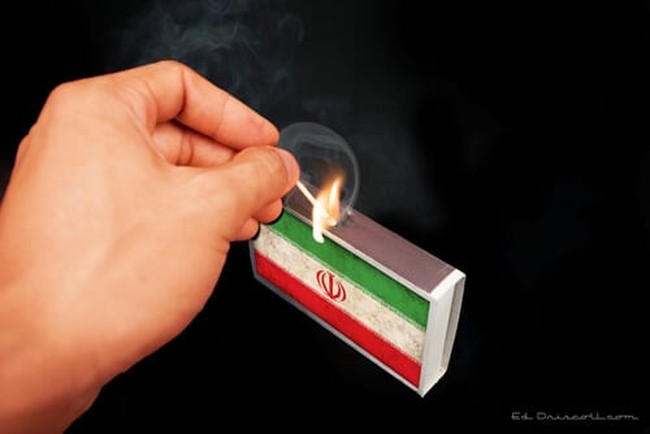
In a process of profound importance, five Arab states in the Middle East have effectively ceased to exist over the last decade. The five states in question are Iraq, Syria, Lebanon, Yemen and Libya. It is possible that more will follow.
The causes of their disappearance are not all the same. In two cases (Iraq, Libya) it was western military intervention which began the process of collapse. In another case (Lebanon) it is intervention from a Middle Eastern state (Iran) which is at the root of the definitive hollowing out of the state.
But in all these cases, the result has been remarkably similar — it is the ceding of power from strong central authorities to a variety of political-military organizations, usually but not always organized around a shared sectarian or ethnic origin. The Middle East today is overshadowed by this process. We are living in the time of the militias.
Observe: in Syria, the clearest-cut case, the country is now effectively separated into separated ethnic and sectarian enclaves — an area dominated by Bashar Assad in the south and west, an area dominated by the Sunni jihadi Islamic State group in the east, three non-contiguous Kurdish enclaves across the north, an area under the domination of al-Qaeda and its allies in the northwest and a small area in the southwest held jointly by al-Qaeda and a variety of other Sunni Arab militias supported by the west.
The important point to note here is that the area controlled by Assad (around 40% of the total area of Syria) does not essentially differ in its militia-nature from the other areas.
On the contrary, Assad has been able to survive because he is aligned with the force best designed to successfully exploit the fragmentation of Arab states and the emergence of militias seeking to impose their authority on the ruins of the state.
This force is Iran, and more specifically the Iranian Revolutionary Guards Corps and its Qods Force.
This force is a unique body. It exists for the precise purpose of building proxy paramilitary organizations to serve the Iranian regional interest. At a time like the present, the possession of such a force is an enormous advantage.
Assad’s large, mainly Sunni Arab conventional army became largely useless to him in 2011/12. The IRGC stepped in and created for him one of its own preferred force types. Today, this militia (the National Defense Forces) along with other Iranian-created or -sponsored militia forces from neighboring Iraq and Lebanon are largely responsible for Assad’s survival. But he survives as a warlord and militia chief, not as a “president” or the head of a state.
In Iraq, the country is today separated into three areas, a Kurdish north, an area in the center controlled by Sunni jihadis and a Shia area in the south. Again, the Shia south, which is still seen in the west as the “legitimate” government of Iraq, is in fact an area in which Shia militias are the key element, operating freely and acting according to their own will. Often, this will is the product of the desires of the Qods Force, and its commander General Qassem Suleimani.
In Lebanon, in a notably different process, an Iran-created militia, Hizballah, acquired the dominant role in the area once ruled by the state, because the state was a hollow construct long competed over by rival sectarian militias, and because Iranian and Syrian support enabled Hizballah to acquire a level of strength which no other homegrown political-military force could match. It may well be that this is now changing, as al-Qaeda associated Sunni militias enter the arena.
In Yemen, where the state and central government was also weak, the Iranian supported militia Ansar Allah (the “Houthis”) seized the capital in January. Sunni elements in the south, including one of the strongest franchises of al-Qaeda, are fighting against them. A mobilization of Arab air and sea power is underway to prevent Iran’s proxies from seizing the Bab-el-Mandeb strait. Control of this vital waterway, between the Gulf of Aden and the Red Sea, would tilt the regional balance yet further in Iran’s favor.
Finally, in Libya, the western destruction of the Gadaffi regime has led to the splitting of the country between two rival governments — one supported by the Egyptians in Tobruk, another backed by Islamist militias in Tripoli.
Five Arab states, effectively no longer in existence. In all, militia power has replaced ordered government.
What does all this mean for the region? It means that a huge chunk of the long misgoverned Middle East has exchanged an age of despotic torpor for an age of chaos. The Iranians, because of their matchless IRGC, are best equipped to make gains from this.
But nowhere (with the partial exception of tiny Lebanon) have the Iranians yet succeeded in keeping a country united under the control of their local proxy. This is not a story of an unstoppable Iranian advance, like a juggernaut, across the region. Their successes are notable, but partial in each area of operation. Sunni and Kurdish forces prevent their complete victory and are likely to continue to do so.
Where will all this end — what will the landscape look like when the storm passes? Impossible to say.
But it may be said with certainty that the shadow of the gunmen is today hanging over the Middle East, all the way from the Iraq–Iran border to the Mediterranean coast and from the Gulf of Aden to Libya.









Join the conversation as a VIP Member